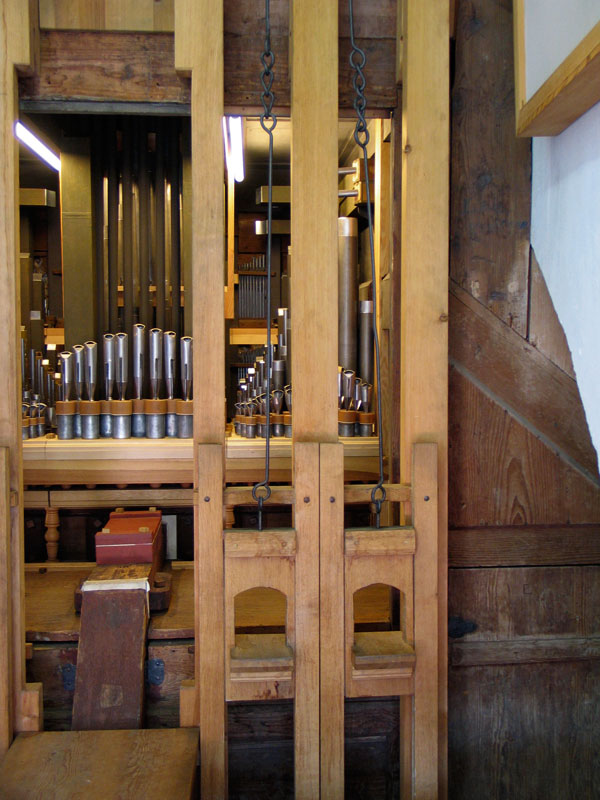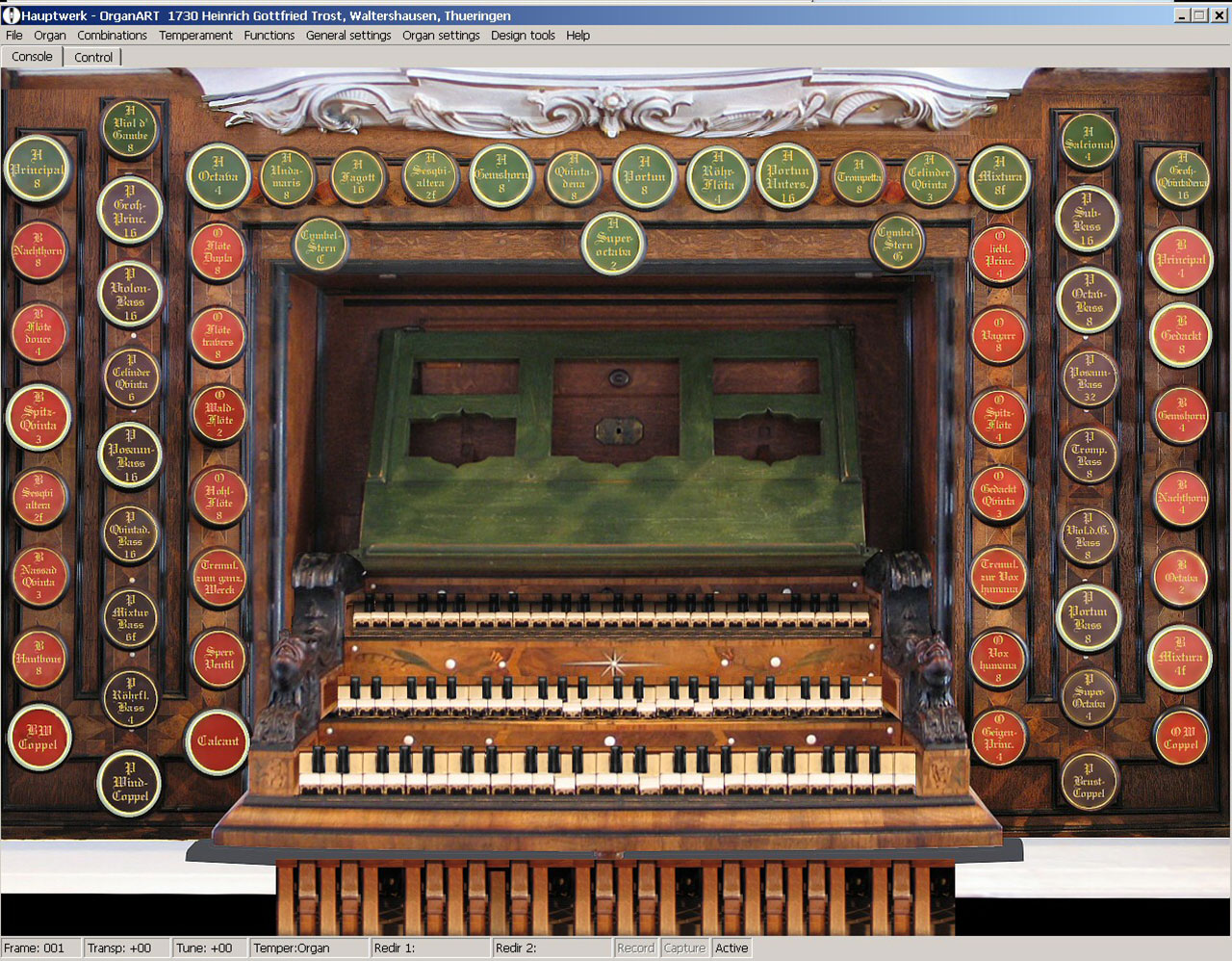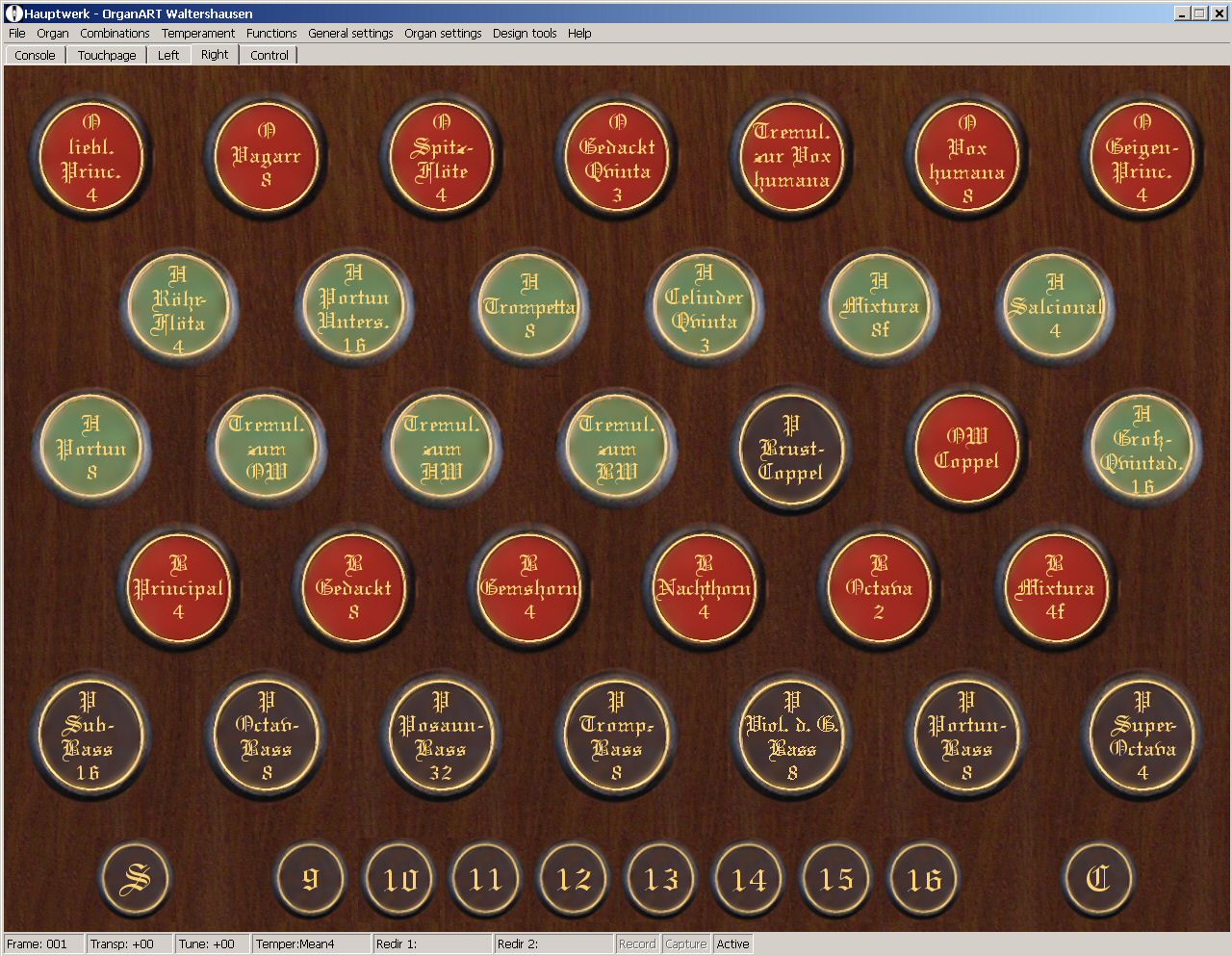1730 Tobias-Heinrich-Gottfried-Trost Organ
Ev.-Luth. Stadtkirche Waltershausen/Thüringen, Germany
Short Introduction and History
The Trost organ of Waltershausen, with its 47 stops and 6 transmissions, is the biggest baroque organ in Thuringia. It is largely preserved in its original state of 1730 (a good 70% of the pipe material was built by Trost) and therefore is an invaluable reference when performing organ music by J. S. Bach and his contemporaries. Today this organ is viewed as an important authentic "Bach organ".
The organ was built in 1724–30 by Tobias Heinrich Gottfried Trost, but due to several specification changes and severe conflicts between Trost and the Waltershausen parish, it was not completed until around 1755, probably by the organ builder Johann Heinrich Ruppert. The instrument has survived without major changes, and was brought back to its 1730 state by Orgelbau Waltershausen during the years 1994–98.
It is a typical instrument of the Thuringian organ building school with ranks such as a Violonbass, mixtures containing thirds, Sesquialtera, and Viola di Gamba, etc. This, and the richness of well-blending stops allowing endless sound combinations, already anticipates the romantic organ of a century later in a fascinating way.
Trost's outstanding and innovative concepts using unconventional and extreme pipe measurements in stops like the Geigenprincipal, Flauto traverse, Vagarr, but likewise stops with a delicate sweetness preferred by Bach, such as the Flauto dolce, Flöte dupla and Nachthorn etc., also support the upcoming gallant style. The firm ground tone (German "Gravität") demanded by Bach is realized by three 16 foot manual ranks, a 16 and 32 foot Posaune in the Pedal, no less than 12 eight foot flue stops in the three manual divisions, rich mixtures as well as two Sesquialtera stops. The instrument has an extremely rich plenum sound, while never forcing the sound.
The organ facade, designed by Johann Eberhard Strassburger, the architect of the Anna-Amalia library of Weimar, and the console are of unrivalled beauty. Even the manuals are original.
Although we don't know for sure, it is likely that Bach played this organ. We do know that he expressed his highest appreciation for the beautiful sound and good craftsmanship of Trost's organs while visiting the Trost organ of Altenburg in 1739.
The church architecture, which apparently was a predecessor of the Dresden Frauenkirche, was designed by Wolf Christoph Zorn of Plobsheim. This special architecture, uniting altar, pulpit and organ, perfectly realizes the Lutheran liturgical idea. Therefore the organ is located above the altar (also found in the Frauenkirche Dresden).
The church room has semi-dry acoustics with about 2.5 seconds of reverberation.
See Location in Googlemaps
Recording technique
The organ was recorded in July/Aug. 2008 with 48 kHz, 24 bit, multi-channel for Hauptwerk 3, using the multi-release technique introduced by OrganArt. The stops were recorded with multiple release levels for short, medium and long key attacks for optimal acoustical mapping. All manual reed ranks and Oberwerk ranks were additionally recorded with the original tremulant sound.
Thanks
I would like to thank the parish of Waltershausen for supporting this project.
Special thanks are due to main organist Theophil Heinke for local assistance as well as Orgelbau Waltershausen for a lot of helpful information and discussions!
Last but not least special thanks to my wife, who assists all projects and is responsible for the photo documentation.
Virtual Console
Specification
Temperament: Special modified mean-tone temperament , 5th comma (a1= 466,8 Hz, 15°C)
NOTE: Click on the stop names for a small sound demo!
Requirements
Loaded Version |
Memory Requirements 3) |
Processor Speed |
|
16-bit, compressed1), singe loop |
3100 MB |
≥ 2 GHz DualCore 2) |
|
16-bit, compressed, all loops |
3400 MB |
≥ 2 GHz DualCore 2) |
|
24-bit, compressed, all loops |
6500 MB |
≥ 2 GHz DualCore 2) |
1) Lossless compression (no loss of sound quality!)
2) Minimal configuration: Dual-Core, 4 GByte main memory, optimal configuration: QuadCore, 8 GByte RAM
3) To load this organ into Hauptwerk you will need enough free memory in your computer, due to the amount of playable stops, not including the operating system or any other programs that may be running!
We recommend a professional audio card (e.g. RME-Series) and a studio headphone (e.g. AKG Reference Headphone K701, K712) for optimal sound and room impression.
Demos
The following demo pieces were recorded with the Hauptwerk Advanced Edition software and the Trost virtual organ sample set, with no additional effects processing.
Live recorded demos by Anton Doornhein, NL:
J. S. Bach (1685-1750)
Passacaglia c-moll BWV 582 13:50 min | Registration
Partita "Sei gegrüßet, Jesu gütig" BWV 768 20:17 min | RegistrationPraeludium C-Dur BWV 547 4:33 min
HW: Principal 8, Portun 8, Octava 4, Rohrflöte 4, Super-Octava 2, Mixtura 6-8f, BW-HW
BW: Gedackt 8, Nachthorn 8, Principal 4, Nachthorn 4, Octava 2, Mixtura 4f
PED: Groß-Principal 16, Violon-Baß 16, Sub-Baß 16, Octaven-Baß 8, Celinder-Qvinta 6,
Posaunen-Baß 16, Trompetten-Baß 8, HW-P, BW-P
Fuga C-Dur BWV 547 5:05 min
HW: Principal 8, Portun 8, Octava 4, Rohrflöte 4, Celinder-Qvinta 3, Sesqvialtera 2f,
Super-Octava 2, Mixtura 6-8f, BW-HW (+ Groß-Qvintadena 16, + Fagott 16, + Trompetta 8)
BW: Gedackt 8, Nachthorn 8, Principal 4, Nachthorn 4, Gemshorn 4, Octava 2 (+ Mixtura 4f)
PED: Groß-Principal 16, Violon-Baß 16, Sub-Baß 16, Octaven-Baß 8,
Posaunen-Baß 32, Posaunen-Baß 16, Trompetten-Baß 8, HW-P, BW-P (+ Celinder-Qvinta 6)
Partita "O Gott, Du frommer Gott" BWV 767
Choral HW: Portun-Untersatz 16, Portun 8, Principal 8
Var 1 HW: Portun 8, Principal 8, Rohrflöte 4 BW: Gedackt 8, Flöte douce 4
Var 2 OW: Flöte Dupla 8, Spiz-Flöte 4
Var 3 HW: Groß-Qvintadena 16, Rohrflöte 4, Fagott 16 OW: Hohl-Flöte 8, Wald-Flöte 2
Var 4 BW: Nachthorn 8, Nachthorn 4,
Var 5 HW: Quintadena 8, Rohrflöte 4 BW: Hautbous 8,
Var 6 OW: Flöte Dupla 8, Hohlflöte 8
Var 7 HW: Portun 8, Und Maris 8,
Var 8 HW: Principal 8, Portun 8, Rohrflöte 4, Octava 4, Super-Octava 2, Mixtura 8f
+( Portun-Untersatz 16, Sesquialtera, BW-HW)
BW: Gedackt 8, Principal 4, Flöte douce 4, Spitz-Qvinta 3
+ (Nachthorn 8, Octava 2, Sesquialtera)
Musicalisches Opfer, Ricercare à 6 BWV 1079 9:25 min
Musicalisches Opfer, Trio in c BWV 1079 8:25 min
Samuel Scheidt (1587-1654):
Modus ludendi pleno Organo pedaliter à 6 Voc. (Mean tone 6th comma) 2:15 min
Numerous other live recordings can be found on the ConcertHall Website
(Advanced Search, Organ: OAM - Trost Organ Waltershausen)
© Organ Art Media, all rights reserved
No demo sounds may be used or transmitted in any form for public purposes without the prior permission of the publisher!
Further Information and Media
YouTube Videos
Tour of Stops, Bálint Karosi, Ungarn
Tour of stops, virtual instrument, Paul Fey, Deutschland
Die Trost-Orgel und Stadtkirche "Zur Gotteshilfe" Waltershausen
(Festschrift zur Orgelweihe und Restaurationsbericht mit Beschreibung aller Register)
Waltershausen 1998, Online Shop Waltershausen
Die Orgeln von Tobias Heinrich Gottfried Trost
Felix Friedrich, Verlag Klaus-Jürgen Kamprad, 2001, ISBN 3-930550-17-2
Online Shop Waltershausen
Discography (Selection):
Bach Greatest organ works, Vol 1 DVD Video
Geneon entertainment 11504
Bach Greatest organ works, Vol 2 DVD Video
Pioneer Hyperium PC-11579
Klangfaszination Trostorgel Vol. 1
Thürniger Komponisten des 17. und 18. Jahrhunderts
T. Heinke, Orgel
J.S. Bach, Pachelbel, J.C. Bach, J.M. Bach, Walter, Kittel, Kellner
Artifex, ARCD0303
Klangfaszination Trostorgel Vol. 2
Romantische" Stücke von Komponisten des 19. Jahrhunderts
T. Heinke, Orgel
Karg-Elert, Mendelssohn. Rheinberger, Liszt, Ritter, A.L Peace, S.J. Rowton, T. Adams
Artifex, ARCD
Choräle BWV 651-668 "Leipziger-Choräle"
Cristina Garcia Banegas, organ
Motette , DDD, 99
Choräle BWV 669-689 "Orgelmesse"
Margaret Phillips
Regent REGCD276, 2007
Organ Chorales form the Neumeister collection
BWV 714, 719, 742, 957, 1090-1095, 1097-1120
Kay Johannsen, organ
Hänssler Edition Bachakademie 2000, CD92.086
Bach - Organ Works Vol. 10
Gerhard Weinberger, organ
Präludium & Fuge C-Dur, BWV 547
Choräle aus der Leipziger Handschrift, BWV 659-668 a
Präludium & Fuge h-moll, BWV 544
Toccata d-moll, BWV 913a
cpo 999 756-2
Bach in Waltershausen
Ewald Kooiman, organ
Präludium & Fuge G-Dur, BWV 541
Partita "Ach was soll ich Sünder machen", BWV 770
Fantasia "Jesu, meine Freude", BWV 713
Toccata d-moll, BWV 913a et al.
Georg Böhm, Orgelwerke Vol1(1)
Ars Musici, CD, 2000
Orgelfestwoche Waltershausen -
Meisterinterpreten spielen die restaurierte Trost-Orgel
Ton Koopmann, Bernhard Klapprott, Ludger Lohmann
CD 1 zur Wiedereinweihung der Trost-Orgel
J.S.Bach: Fuge g-moll & C-Dur, Choralbearbeitungen BWV 641, 642, 645, 659
C.P.E.Bach: Sonate 1 D-Dur, A.G.Ritter: 2.Sonate e-moll
Pachelbel / Rinck / Brahms et al.
Orgelfestwoche Waltershausen
Heitere Orgelmusik „nicht ganz bei Trost“
CD 2 zur Wiedereinweihung der Trost-Orgel
T. Heinke, Orgel
4 Tänze der Renaissancezeit
Stephan Nusser: "Thüringen-Fuge"
Vincenco Bellini: Allegro aus Sonata D-Dur
Wolfgang A.Plagiavski Mozart: 4 Stücke für Trompetenuhr;
Theophil Heinke: Nahost-Vision
A lot of CDs can directly be ordered via Online Shop Waltershausen
James Kibbie playing Bach at Waltershausen et al (including registrations)
© OrganArt Media, all rights reserved
No demo sounds may be used or transmitted in any form for public purposes without the prior written permission of the publisher!













